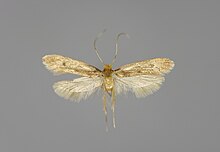Phalaena (Tinea) pellionella
| Case-bearing clothes moth | |
|---|---|
 |
|
| Case with pupal skin (above) Adult moth (below) |
|
 |
|
| Scientific classification | |
| Kingdom: | Animalia |
| Phylum: | Arthropoda |
| Class: | Insecta |
| Order: | Lepidoptera |
| Family: | Tineidae |
| Genus: | Tinea |
| Species: | T. pellionella |
| Binomial name | |
|
Tinea pellionella Linnaeus, 1758 |
|
| Synonyms | |
|
Several, see text |
|
Several, see text
Tinea pellionella, the case-bearing clothes moth, is a species of tineoid moth in the family Tineidae, the fungus moths. It is the type species of the genus Tinea, which in turn is the type genus of the subfamily, family, as well as the superfamily Tineoidea. Its scientific name is derived from "tinea", a generic term for micromoths, and the Latin term for a furrier, pellionellus.
This species has a cosmopolitan distribution, occurring nearly worldwide. It is synanthropic; the adult is typically encountered during summer and early autumn, but populations that live in human dwellings may be seen at other times of the year.
Tinea pellionella is silvery grey to shiny light brown in color, with dark grayish hairs on the top of its head. The adult of this species has a wingspan of 9 to 16 millimeters. Its forewings are grizzled brown with one large spot and a few smaller, indistinct black spots. The hindwings are plain pale brown-grey. The forewings, but especially the hindwings are surrounded by a hairy fringe. The larva eats mainly fibrous keratin, such as hairs and feathers. It can become a pest when it feeds on carpets, furs, upholstery, and woolen fabrics. It also consumes detritus, cobwebs, bird nests (particularly of the domestic pigeon), stored vegetable produce and wallpaper. It stays inside a snug case it constructs from debris such as fibers and hairs.
...
Wikipedia
